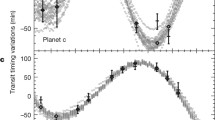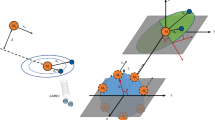Abstract
The Sun's gradual brightening will seriously compromise the Earth'sbiosphere within ∼ 109 years. If Earth's orbit migrates outward,however, the biosphere could remain intact over the entiremain-sequence lifetime of the Sun. In this paper, we explore thefeasibility of engineering such a migration over a long timeperiod. The basic mechanism uses gravitational assists to (in effect)transfer orbital energy from Jupiter to the Earth, and therebyenlarges the orbital radius of Earth. This transfer is accomplishedby a suitable intermediate body, either a Kuiper Belt object or a mainbelt asteroid. The object first encounters Earth during an inward passon its initial highly elliptical orbit of large (∼ 300 AU)semimajor axis. The encounter transfers energy from the object to theEarth in standard gravity-assist fashion by passing close to theleading limb of the planet. The resulting outbound trajectory of theobject must cross the orbit of Jupiter; with proper timing, theoutbound object encounters Jupiter and picks up the energy it lost toEarth. With small corrections to the trajectory, or additionalplanetary encounters (e.g., with Saturn), the object can repeat thisprocess over many encounters. To maintain its present flux of solarenergy, the Earth must experience roughly one encounter every 6000years (for an object mass of 1022 g). We develop the details ofthis scheme and discuss its ramifications.
Similar content being viewed by others
References
Ahrens, T.J. and Harris, A.W.: 1992, Nature 360, 429.
Battin R.H.: 1987, in: An Introduction to the Mathematics and Methods of Astrodynamics, AIAA Education Series, American Institute of Aeronautics and Astrodynamics, New York, NY.
Bond, V.R. and Allman, M.C.: 1996, in: Modern Astrodynamics, Princeton University Press, Princeton, NJ.
Bond, V.R. and Anson, K.W.: 1972, J. Spacecraft & Rockets 9, 460.
Innanen, K., Mikkola, S. and Wiegart, P.: 1998, Astron. J. 116, 2055.
Jewitt, D.: 1999, Ann. Rev. Earth Planet. Sci. 27, 231.
Kasting, J.F.: 1988, Icarus 74, 472.
Melosh, H.J., Nemchinov, I.V. and Zetzer, Yu.I.: 1994, in: T. Gehrels (ed.), Hazards due to Comets and Asteroids, University of Arizona Press, 1111.
Minovitch, M.A.: 1994, J. Spacecraft & Rockets 31, 1029.
Nakajima, S., Hayashi, Y.Y. and Abe, Y.: 1992, J. Atmos. Sci. 79, 37.
Niehoff, J.C.: 1966, J. Spacecraft & Rockets 3, 1351.
Pollack, J.B. and Sagan, C.: 1993, in: Resources of Near Earth Space, University of Arizona Press, 38.
Sackmann, I.-J., Boothroyd, A.I. and Kraemer, K.E.: 1993, Astrophys. J. 418, 457.
Solem, J.C.: 1991, Los Alamos National Lab Rept. LA-UR-91-3765.
Sridhar, S. and Tremaine, S.: 1992, Icarus 95, 86.
Weissman, P.R.: 1994, Nature 368, 687.
Author information
Authors and Affiliations
Rights and permissions
About this article
Cite this article
Korycansky, D., Laughlin, G. & Adams, F.C. Astronomical Engineering: A Strategy For Modifying Planetary Orbits. Astrophysics and Space Science 275, 349–366 (2001). https://doi.org/10.1023/A:1002790227314
Issue Date:
DOI: https://doi.org/10.1023/A:1002790227314




